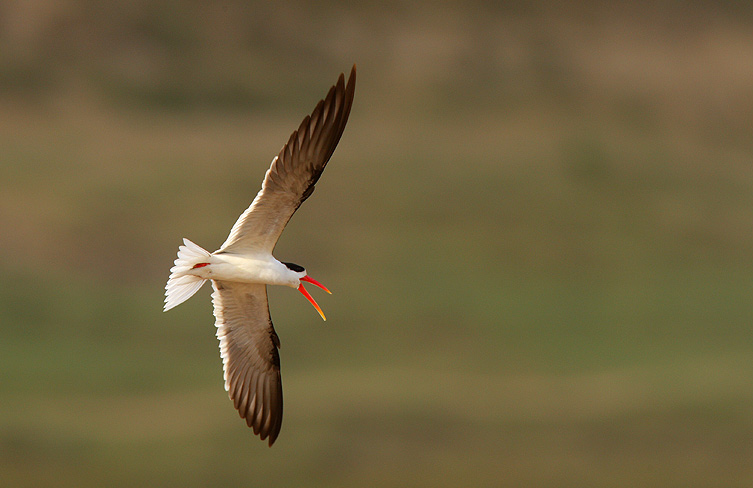- Indian Skimmer (bird)
Taxobox
name = Indian Skimmer
status = VU | status_system = IUCN3.1

regnum =Animal ia
phylum = Chordata
classis = Aves
ordo =Charadriiformes
familia = Rynchopidae
genus = "Rynchops"
species = "R. albicollis"
binomial = "Rynchops albicollis"
binomial_authority = Swainson, 1838
synonyms = "Rhynchops albicollis"The Indian Skimmer ("Rynchops albicollis") is a species of
bird , one of three members of theskimmer family. It is found in southernAsia where it is patchily-distributed and declining in numbers.Description
It is 40-43 cm long with a wingspan of 108 cm. It is black above and white below with a white collar and forehead. The wings are long and pointed with a white trailing edge. The short, forked tail is white with blackish central feathers. The long, thick bill is orange with a yellow tip and, like the other skimmers, has a lower
mandible which is longer than the upper mandible. The legs and feet are red.Non-breeding adults are duller and browner than breeding birds. Juveniles are grey-brown above with pale fringes to the feathers on the back and wings. The head has more white than in adult birds and the bill is orange-brown with a dark tip.
It has a high, nasal, screaming call but is often silent.
The
Black Skimmer of theAmericas is larger with a black tip to the bill. TheAfrican Skimmer is smaller with more black in the tail and no white collar.Habitat and distribution
It is found on large rivers and lakes, swamps and coastal wetlands such as estuaries. It is most common on freshwater, particularly during the breeding season. Breeding colonies are on islands or sandy spits, usually in rivers.
Its range has become increasingly fragmented in recent decades. It is still found in parts of
Pakistan , northern and centralIndia ,Bangladesh andBurma and formerly occurred inLaos ,Cambodia andVietnam . It is a scarce non-breeding visitor toNepal and has occurred as a vagrant inOman and centralThailand with old records fromIran andChina .Behaviour
The birds forage for food by flying low over the water with the bill open and the lower mandible skimming through the water. They feed mainly on
fish but also take smallcrustacean s andinsect larva e. They often feed at dusk and through the night.They breed in colonies of up to 40 pairs, often with terns and other birds. The
nest is a simple scrape on the ground. The eggs are usually laid between March and May. They are buff or white with brown blotches and streaks. There are three to five eggs in a clutch.Conservation
The species has a decreasing population of 6,000-10,000 individuals and is classed as Vulnerable by the
IUCN . It is threatened by habitat loss and degradation, pollution and disturbance by humans. Most colonies are unprotected but some lie within nature reserves such asNational Chambal (Gharial) Wildlife Sanctuary in India.References
*aut|Birdlife International (2003) [http://www.rdb.or.id/view_html.php?id=275&op=ryncalbi Indian Skimmer "Rynchops albicollis".]
*aut|BirdLife International (2007) [http://www.birdlife.org/datazone/species/index.html?action=SpcHTMDetails.asp&sid=3206&m=0# Species factsheet: "Rynchops albicollis".] Downloaded from http://www.birdlife.org on 13/8/2007.
* (1987) "A Field Guide to Seabirds of the World", The Stephen Greene Press, Lexington, Massachusetts.
*aut|Robson, Craig (2002) "A Field Guide to the Birds of South-East Asia". New Holland, London.External links
* [http://www.orientalbirdimages.org/search.php?action=searchresult&Bird_ID=940 Oriental Bird
]
Wikimedia Foundation. 2010.
